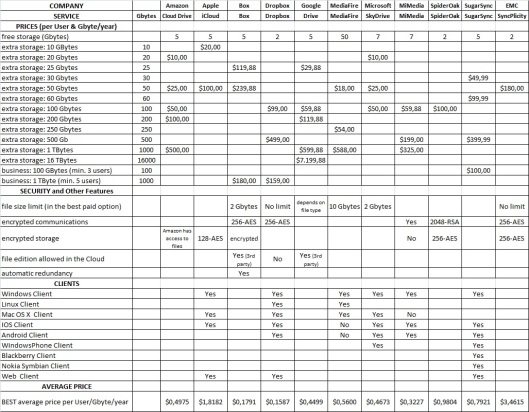Recently (on 12 February 2013) Gartner has
published its “MarketScope for Enterprise File Synchronization and Sharing”.
Quoting to Gartner, “Enterprise file synchronization and sharing (EFSS)
offerings enable productivity and collaboration for mobile workers who use
multiple devices, such as smartphones and media tablets, in addition to PCs.
Organizations must deploy EFSS services to secure enterprise information assets.
Failure to provide these capabilities will subject organizations to information
leakage threats caused by users who move data through uncontrolled personal
cloud services”.
When I read this article, I recognize the
generalization (as the same Gartner states in its report) of the concept of
“Personal Cloud” (going, and widening, from the personal needs to
the workers and company needs: the EFSS, subject on which I come back in the
future), about what I spoke several times in this blog last year (e.g.
”Market
Analysis of Personal Cloud Services”, “Personal Cloud, pending
challenges”, “Discussion on Gartner Forecast about Personal Cloud”, or “StackSync“).
As the name of one of those post announces, I‘ve
already made a short analysis of the market at the date of the study (may 2012) and even shorter
review of some products available in that moment: Dropbox, Google Drive (it that
date just appeared), Microsoft SkyDrive, iCloud of Apple, SugarSync, Box, Cubby,
Cubby, Insync, Wuala, Syncplicity (now acquired by EMC) and OwnCloud.
So, by the end of that year (2012) I decided to
go more deeply into that study and I gathered when possible more data to widen
the study scope. It was quite difficult, in short, because the market is still
immature, as I’ve already said in some old post. About the market, in general, I
keep my
main old conclusions and expand them with the following ones:
- The market is highly fragmented
- A lot of small suppliers
- Great dynamism
- Mergers, acquisitions and consolidation will become common, since some big players are still outside of the market right now.
- It’s quite difficult to compare prices because of:
- Some provider limit the files size (even depending in the file type).
- Other ones limit the number of transactions (or bill for them).
- Other ones limit the downloading traffic (or bill for them).
- Others limit the number of User’s devices to synchronize.
- In general the billing policies are pretty disparate: from flat rate to billing for number of users, per space quota, per downloads, per a combination of two o more of them, and so on.
- etc.
- Very different technologic performances, as well as continuous improvements (several at the year) make difficult to compare vendors or providers based on their current features:
- Available clients and supported devices
- Redundancy and number of copies of the stored information
- Security in communication
- Security in stored information
- Laws and regulation (specially about privacy) accomplishment
- Service and support are highly variable from provider to provider, so it isn’t almost impossible to compare them.
As just stated it is not easy to compare services
but to be hones it’s still more difficult because in most the cases not all the
needed information is publicly available in the web site of companies: so, if
you aren’t Gartner, you have ask that information or to sign for a free trial
(where the performances are not the same of the real services), and so on. In
this way I must mention too, that it was helpful the work made by other people,
since I found related reports with valuable information. So when I compare all
the information I decided not publicize because there are a lot of blank cell:
comparison is not possible. However, after reading the aforementioned Gartner
report, where they left out a lot of important players (for good and explained
reasons) as Dropbox, Apple (iCloud), Microsoft (SkyDrive) and Google (GDrive),
ownCloud and others, I decided to publish my results because some of them are in
my table.
Prior to show my comparison table, please let me
see it again:
- When you see a blank cell in my comparison table just implies that I’VE NOT BE ABLE to get the information.
- And the comparison took me a couple of months (I do it in my free time) so I compare services at different dates.
- And it was finished in the first half of the last December (so these results today could, and probably will, be different)
- Frankly, I also must state that I use several reports that I found about this subject (introducing a wider time gap).
- Note: I’ve got the time and the Gartner permission; in future post I’ll summarize the Gartner’s “MarketScope for Enterprise File Synchronization and Sharing” report.

No hay comentarios:
Publicar un comentario